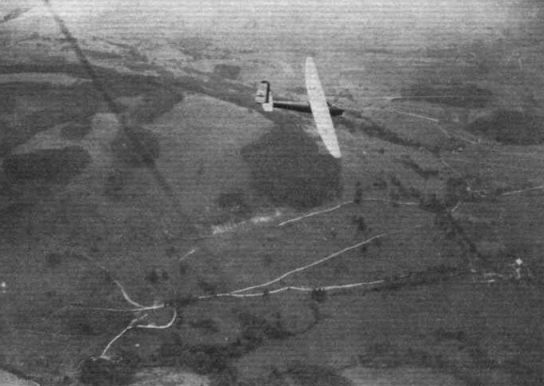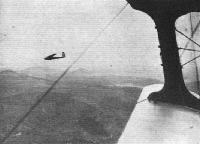
M.Simons The World's Vintage Sailplanes 1908-45
THE DARMSTADT SERIES AND MUSTERLE
When in 1926 the Darmstadt Akaflieg were looking around for new fields to conquer, the students had few doubts about what they should do. The Konsul had the right layout and proportions. The pilot's head stuck out just in front of the wing, disturbing the airflow over the critical top surface and there were awkward corners under the wing roots. It might pay to raise the wing on a short pylon, to get it clear of this interference. Long, narrow ailerons instead of broad triangular surfaces, would also be better. The tail unit could be improved in sensitivity without increasing stick forces, by making both vertical and horizontal surfaces all-moving. New theories showed that a wing of elliptical planform would give less induced vortex drag than any other shape. Such a wing was hard to build, but a very close approximation resulted if the centre section was made rectangular and only the outer tips curved. This fitted in admirably with the intended narrow-chord ailerons and the usual simple three-piece wing rigging system. The wingspan was reduced, for Bubi Nehring declared he needed a more manoeuvrable craft. The new Darmstadt sailplane was completed in time for Nehring to fly it in the 1927 Wasserkuppe competition. Nehring was already the acknowledged master of slope soaring. He spent many hours studying detailed contour maps of the Rhoen district, toured round extensively on his motor cycle to view possible soaring routes, and worked out possible procedures for every wind direction. In a district like the Rhoen there were many exciting possibilities awaiting exploration. Nehring’s best flight of 1927 broke no record, but covered 51.8 km, as he followed the slopes and had studied each move before making it. Here and there he called down gaily to people on the ground as he skimmed only a few metres above their heads. He landed at last, downwind, in a pasture. Undoubtedly on some of his flights, Nehring gained unexpected altitudes in thermals, in places where he could only have expected sinking air. Almost certainly he would not have realised what the cause was.
A few months after this Rhoen meeting, the Darmstadt left Germany. A group in New York formed the American Motorless Aviation Club and, at their invitation, two Darmstadt students, Hesselbach and Laubenthal, accompanied by an experienced instructor. Captain Rohre, took the sailplane to the USA. The Germans camped at Cape Cod where sand dunes faced the Atlantic. On June 26 1928, a strong north-easterly blew from the ocean and, with the help of local golfers, Peter Hesselbach was catapulted off the dunes to make the first true soaring flight in the New World since the Wright brothers' brief efforts of 1911. Before the end of the week, Hesselbach raised his figure to more than four hours. A wave of enthusiasm for the new sport swept America.
The Darmstadt was eventually wrecked at Cape Cod, but the wreckage was bought by the local enthusiasts and carefully rebuilt, with numerous improvements. The whole front fuselage was redesigned, a wheel was installed and an enclosed transparent canopy was fitted. Re-christened Chanute, the Darmstadt appeared at all the important eastern states gliding meetings for some years afterward, usually being flown by Jack O’Meara.
Meanwhile the students had been busy again. The demand for better performance led to an increased wingspan for the Darmstadt 2. A new wing section was tried following the theoretical Joukowsky computing methods, which enabled a profile to be designed to a particular formula for a particular purpose. The fuselage and tail unit of the new aircraft were not greatly altered but the span was almost as great as that of the old Konsul. Nehring took the Darmstadt 2 to the French contest at Vauville in July 1928, and returned again to the Wasserkuppe in August. He demonstrated his superb skill in slope soaring, carrying off the world distance record with a flight of 71.2 km. In the following year, trying for the prize offered by a newspaper, for the first distance flight to reach 100 km, he squeezed another few km to set the record at 72.3 km and on the same occasion made an ascent, probably helped by unsuspected thermal lift, of 1209 metres.
Contemporary with the Darmstadt 1 and 2, a whole group of similar sailplanes, so much alike that it was hard to tell them apart, came from the Darmstadt school or from other groups. Several were designed by Laubenthal of Darmstadt. There were such types as the Lore, Westpreussen, Wurttemberg, Starkenburg, Schloss Mainberg, Elida and others. The Schloss Mainberg visited the USA where it was flown by Martin Schempp. The Wurttemberg was Wolf Hirth's aircraft, with which he competed at Vauville and carried off more prizes even than Nehring.
The most significant flights of all were by Wolf Hirth in his new type, Musterle (Wanderer), designed by Laubenthal. This was to all intents and purposes an improved Darmstadt I with a slightly taller pylon and an enclosed cockpit canopy made of plywood with open portholes. In 1930, Hirth took the Musterle to the USA.
He entered the American competition at Elmira, N Y. On one flight, under a cloudless sky, Hirth discovered ‘blue’ thermals and used them to make a distance of 53 km. It was no record but it was of great significance. Glider pilots, following Kronfeld and Hirth’s examples, began to turn away from the hills to study the possibilities of soaring over the plains.
In 1931 before returning to Germany he made an astonishing soaring flight over New York. He was catapulted off the Hudson River embankment from about road level and succeeded in soaring along the river frontage, causing a great commotion among the traffic below, until he landed back at his starting place, much to the relief of the police. On the rudder of the Musterle he carefully recorded this exploit along with his earlier successes, including his contest victory at Vauville which was achieved in the Wurttemberg.
The Darmstadt 2 continued in use for years more, competing quite effectively against more modern types until finally it was too badly damaged to be worth repairing, during an expedition to Finland in 1934.
Technical data:
Darmstadt 1: Span, 16.00 m. Wing area, 16.60 sqm. Aspect ratio, 15.4. Flying weight. 250 kg. Wing loading, 15.05 kg/sq m. Aerofoil, Goettingen 535.
Darmstadt 2: Span, 18.00 m. Wing area, 16.90 sqm. Aspect ratio, 19.4. Flying weight. 252.00 kg. Wing loading, 14.9 kg/sq m. Aerofoil, Joukowsky.
- M.Simons The World's Vintage Sailplanes 1908-45
Фотографии
-
Flight 1930-10 / Flight
Stark, on the Darmstadt glider. Snapped from an aeroplane whilst soaring over the western slope of the Wasserkuppe
-
Flight 1930-10 / Flight
The Darmstadt glider soaring over the Gersfelder Valley, as seen from an aeroplane.
-
Flight 1931-06 / Flight
Herr Fuchs of the Akademische Fliegergruppe Darmstadt, landing at Staaken in the "Starkenburg," after having flown from the Tempelhof Aerodrome over the City of Berlin. He was towed up to gain his initial altitude by a Klemm (Argus).
-
GL / M.Simons - The World's Vintage Sailplanes 1908-45 /Kookaburra/
Johannes Nehring with the Darmstadt 1.
-
GL / M.Simons - The World's Vintage Sailplanes 1908-45 /Kookaburra/
The rebuilt Darmstadt 1, renamed Chanute in the USA.
-
GL / M.Simons - The World's Vintage Sailplanes 1908-45 /Kookaburra/
The Schloss Mainberg, described as an improved Westpreussen, in the USA, where it was flown by Schempp.
-
GL / M.Simons - The World's Vintage Sailplanes 1908-45 /Kookaburra/
Nehring about to take off from the Wasserkuppe summit in the Darmstadt 2 during the 1928 Rhoen contest. Note the external instrument housings. In the background of this picture is Kronfeld's Rhoengeist, the prototype Professor.
Другие самолёты на фотографии: Lippisch / RRG Professor - Германия - 1928
-
GL / M.Simons - The World's Vintage Sailplanes 1908-45 /Kookaburra/
The Musterle after launching from the Wasserkuppe. In America, the Musterle was modified by the Haller Hirth Sailplane Company, this fact being recorded on the fuselage. Photographs show that it carried the name Wanderer for some time. The details of the modifications are not known.
-
GL / M.Simons - The World's Vintage Sailplanes 1908-45 /Kookaburra/
A replica of the Musterle rudder built by Klaus Heyn. Hirth painted the record of his exploits on the original.
-
GL / M.Simons - The World's Vintage Sailplanes 1908-45 /Kookaburra/
Eric Collins, the English pilot, flew the Musterle in 1935.
-
GL / M.Simons - The World's Vintage Sailplanes 1908-45 /Kookaburra/
The Darmstadt I was taken to the USA in 1928 and created tremendous excitement by completing many long soaring flights over the sand dunes of Cape Cod. Painting by Norman Clifford.
- Фотографии













